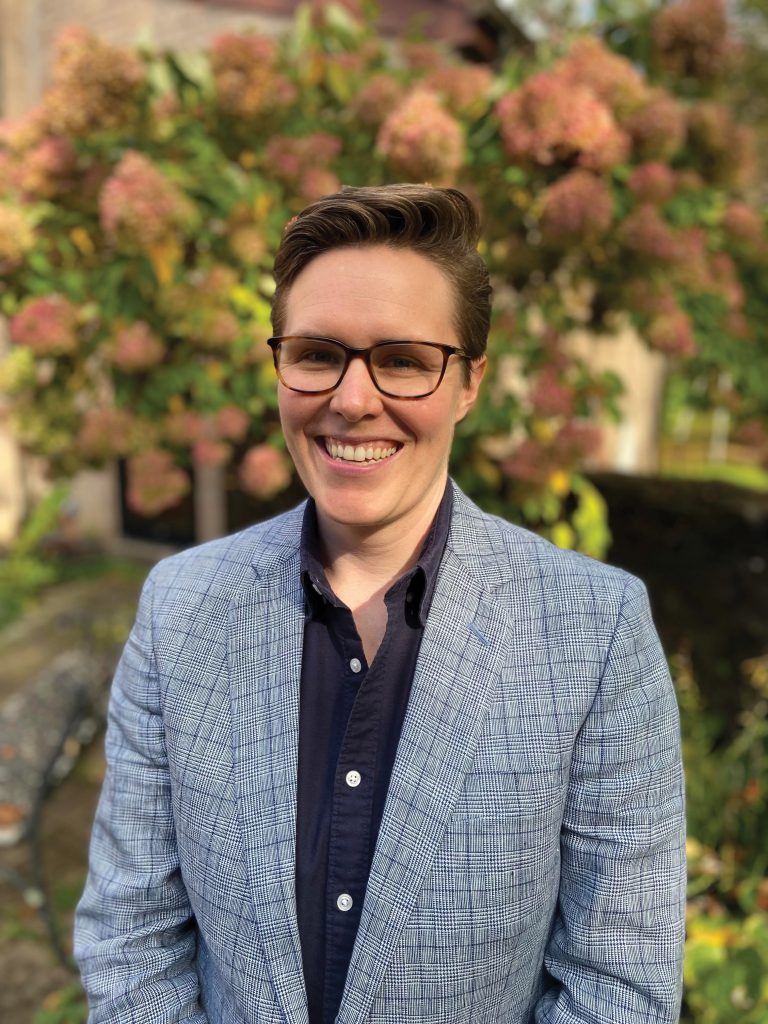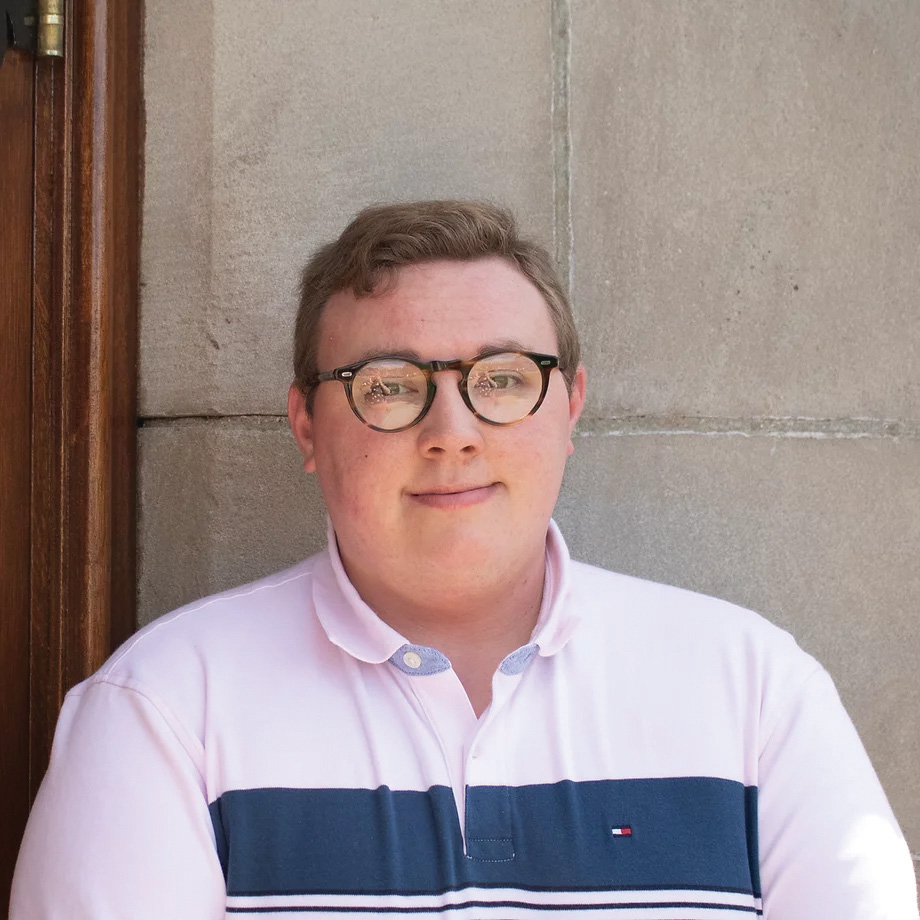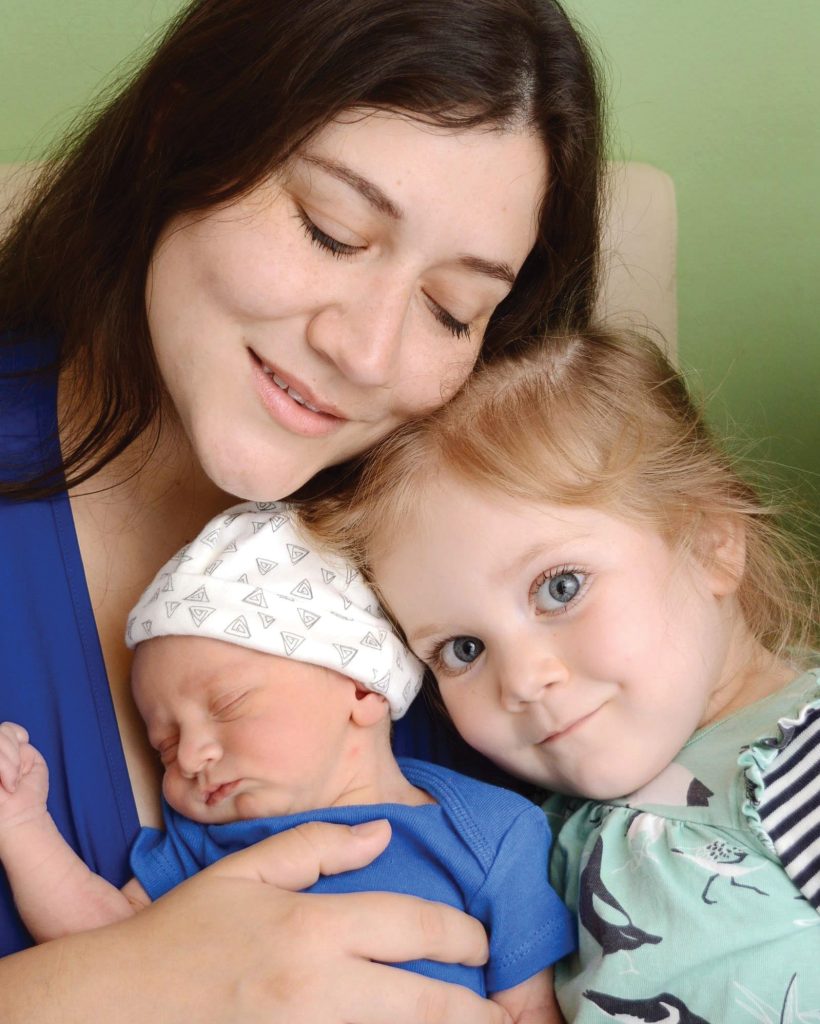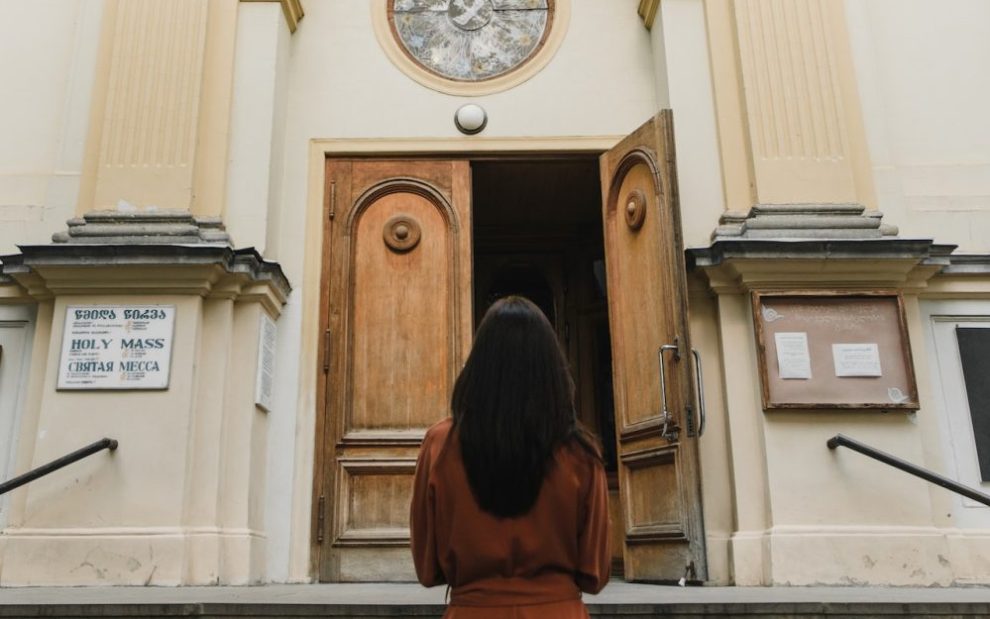Coming up through Catholic schools in New York all her life, Meg Stapleton Smith found herself continually revisiting one question: “What happens to the Catholic Church if all the good people leave?” The response she landed on for the longest time was, “You are then responsible for the future of the church.”
That is a lot to take on oneself. Decades of disaffiliations, which at one point made ex-Catholics the second largest religious demographic in the United States, have been joined in recent years by an accelerated decline in Mass attendance in the wake of the COVID-19 pandemic.
“Every parish is seeing it,” says Michael Sennett, director of communications and coordinator of social justice programming at St. Ignatius of Loyola Church in Chestnut Hill, Massachusetts. Whether in the form of no longer giving, volunteering, or showing up at all, he sees “people willing to put down their foot and say, ‘I’m done.’ ”
Collectively, it’s led to a sense that the church has to do something about those who walk away and don’t come back. At the global level, Pope Francis has called a synodal listening and discernment process for the whole church slated to run into late 2024. The U.S. bishops have initiated their own call for renewed teaching and understanding of the Eucharist. Beneath the surface of each initiative are foundational questions about who gets to call themselves Catholic, who gets to call anything Catholic, and who even wants to be called Catholic.
In the United States, the church hierarchy has continued largely undeterred on a path of making clear that certain identities—whether sexual, political, or otherwise—are irreconcilable with being Catholic. This includes pushes to oppose gay marriage and deny communion to politicians who support legal abortion.
This matters because, when a church—or any group—seeks a strident sense of identity for itself, the members who feel it most are people whose identities place them at the outermost edges. Those people are also most vulnerable to the aggression of other members who police those edges and declare definitively who’s in and who’s out. In the Catholic Church, many people can’t articulate their misgivings with the atmosphere created by the latter group, so instead they simply leave.
This isn’t an indictment of identity itself but rather a call to approach the issue more deeply, to really mine the mission and teachings of the church for their true worth, says Stapleton Smith, whose own journey of identity and belonging brought her to the Episcopal Church and ordination to the priesthood in early 2023. Meanwhile, she maintains a deep love of the Catholic Church that formed her.
Stapleton Smith says, “Not always, but often, some of the ideals and teaching in the Roman Catholic Church that cause the most harm also have the potential to bring about the most healing and the greatest transformation.”
Expansive identities
Many Catholics approach identity destructively because they think of identity as a singular, rigid, unchanging thing, says Brian Flanagan, a Catholic theologian at Marymount University in Arlington, Virginia and president of the College Theology Society.
“One of the great riches of our tradition that you can pick up by studying church history is how varied and diverse various schools of theology, families of spirituality, and forms of worship have been and still are,” he says.

—Meg Stapleton Smith
This can apply to entire groups of people, such as Byzantine Catholics and religious orders, whose traditions and charisms are robustly realized in conjunction with their identities as part of the Catholic Church. On an individual level, it can apply to someone like Flanagan, who is a gay man formed in a historically Irish parish in the Northeast, is an associate of the Paulist Fathers, and worships at a Jesuit parish.
Flanagan concedes that this dappled approach is not the only one to be found in the lived practice of Catholicism and that even the synodal outreach of Pope Francis is a departure from a more strident focus on identity in recent decades.
“I understand the hesitation or frustration . . . of folks who have been formed for the last two pontificates in more of a fortress mentality being asked to change,” he says of resistance to Pope Francis. “There’s a bit of ecclesiological whiplash here.”
But that doesn’t mean the shift in emphasis isn’t necessary, says Taylor Ott, a postdoctoral research fellow at Katholieke Universiteit Leuven in Belgium, who grew up in the United States in the 1990s and early 2000s.
“It has made a couple of unyielding political stances and called that God,” Ott says of the U.S. church. “It’s funny that right-leaning Catholics accuse liberation theology of making the church too political when Catholics’ political stances on abortion and same-sex marriage have stood in for orthodoxy for decades now.”
“The church is much wider, more expansive. We also have to do our part in reclaiming what the church is, what it means, what the community is,” says Sennett. “That spirit of synodality we’re seeing now is doing a lot to move folks in that direction.”
Bishop Christopher Coyne of the Diocese of Burlington, Vermont, takes an approach that acknowledges that what makes people Catholic does not primarily have to do with how they act or even what they believe. It’s their baptism.
“Once you’re baptized, you’re a Catholic . . . until proven otherwise,” says Coyne. “That simple view makes it easier to navigate complex situations in which we find ourselves as a church.”
In general, this means not weaponizing the sacraments, whether the Eucharist against pro-choice politicians or matrimony against cohabiting couples. Coyne will also approve for Catholic burial a baptized person who left the practice of the faith for decades.
“I tend to be very broad, because you never know!” he says.
Generational judgments
Coyne’s philosophy as a Catholic bishop in the United States might not be recognizable to young people who associate the Catholic Church with headlines of bishops stripping the Catholic label from schools that fly rainbow and Black Lives Matter flags or refuse to fire gay teachers. Flanagan and María Teresa (MT) Dávila, chair of religious and theological studies at Merrimack College in North Andover, Massachusetts, often observe this in their students. Flanagan defines it as “deep suspicion of religion in general and the Catholic Church in particular.”
“They’ve experienced real religious harm. Students who come to a Catholic college don’t always arrive linking the public role of the Catholic Church in the United States with an agent of solidarity and justice for oppressed groups,” says Dávila. She adds that it’s not until they get into Christian traditions, such as the church in El Salvador in the 1970s and ’80s or the life of Dorothy Day, that they see “how the Catholic Church can be a space of solidarity and radical welcome.”

—Michael Sennett
But that’s not to say everyone makes that jump. Dávila notes a recent Pew Research Center study that found that, by the year 2070, the religiously unaffiliated could compose a majority of the U.S. population.
“That would say to me, no, people are not sustaining those kinds of tensions, and it’s leading to abandoning the tradition altogether,” she says.
Flanagan notes that, in his generation, the impulse for those who are gay and Catholic was to stay and find a space in the church. But, he adds, the generation behind his doesn’t see the value of staying.
“Very few students don’t have friends who identify as LGBTQ,” he says. “That’s the issue that makes them not even consider the Catholic Church. . . . It feels to them kind of incomprehensible as to why the Catholic Church would even be thinking this way.”
Dávila adds that actions by the church hierarchy that alienate young people don’t pass Catholic muster either. For instance, a rainbow flag can be interpreted along a spectrum that includes welcoming people in their dignity as human beings and not tolerating bullying.
“All of those signals are within Catholic social teaching,” she says. “There’s a point at which that scrutiny and purity culture crosses a line into not being Catholic anymore, not sustaining principles of Catholic social teaching on human dignity and racial justice. . . . They’re applying this identity standard in a way that’s not just unreasonable. It’s unfaithful.”
And the fruits are already here, notes Ott, who says most of the friends she grew up with, as well as others she’s met in adulthood, have disaffiliated.
“This is sad in some ways—sad that they won’t be part of the same religious community, sad that our tradition is unable to recognize the awesome people they are and what they have to give,” she says. “I think with the right community, there are ways that a person can remain Catholic with integrity to their own personhood and well-being. But I would much rather see my friends be happy and give what they have to give to the world than ground down by remaining active in a religious community that isn’t good for them.”
Running out of room
After college, Stapleton Smith took a job as director of campus ministry at a Catholic high school, a role she loved. She left after one year, however, because she found herself living in a state of constant fear stoked by headlines of gay teachers getting fired from Catholic schools.
“I grew more and more terrified of what it would mean if knowledge of my lesbian identity got into the hands of the wrong person,” she says. This fear compounded the prospect of what it would mean to come out of the closet “in a family and an environment that was so deeply Roman Catholic.”

—Maria Mochow
This eventually broke open when she started dating the woman who is now her wife. As she slowly migrated to the Episcopal Church, where her wife is also a priest, Stapleton Smith found herself finally beginning to untangle all the shame she’d absorbed throughout her early life. In doing so, she realized that at least some of her fears of being outed at her former teaching job had been projections. That particular community had been inclusive and accepting, as far as Catholic spaces go. But counter to this realization were the encounters.
“I began to have at this time so many experiences of how many former Roman Catholics come to the Episcopal Church, and they are so angry and hurt,” she recalls. “That anger and hurt deeply damage . . . them and their relationships with God, other people, and themselves.”
Maria Mochow, a California-based writer and former Catholic, knows all too well the poisonous role that a militant, overemphasized sense of identity can have in a Catholic environment.
“You’re not Catholic enough” is how she characterizes the prevailing spirit at the university she attended in the early 2000s, a time when both Catholic and evangelical conservatives felt a sense of cultural dominance. President George W. Bush sailed to reelection, and the long reign of St. Pope John Paul II gave way to that of his chief doctrinal enforcer. While Catholic religious communities and schools that flaunted their orthodoxy found favor with church hierarchy going into the new millennium, many of these have since fallen into scandal over allegations of spiritual and sexual abuse and cover-up from former members and students.
Dávila says that, given human sinfulness, it’s no accident that environments that emphasize purity invariably have this fallout.
“I don’t see a way for me to be doctrinally pure without being violent to another human being,” she says. “It’s a very dangerous claim.” Noting that purity falls beneath charity and the dignity of each person in the faith’s hierarchy of values, she adds, “My faithfulness calls my place to be in the mess, in the gray area. . . . My place is much more clearly with the suffering than with the not.”
While Mochow’s journey eventually brought her into contact with Catholics who took a less sectarian and judgmental approach to their faith, she ultimately could not separate the harm she’d witnessed and experienced from the institution.
“They don’t want to think of that ugliness as part of the package,” says Mochow, drawing lines between sexual abuse, colonialism, and other issues. “The church needs to acknowledge what it’s done and make real reparations for what has happened.”
In his ministry as Vermont’s bishop, Coyne says he is mindful that these experiences are in the lives of people he encounters.
“I try to do everything I can to not be the final break in the link. I try not to add any more wounds,” he says. “When I speak, I try to be aware of the person in the community who’s just hanging on.”
Holding things together
“There’s a deep grief that goes along with it,” says Shanon Sterringer of the process of leaving the Catholic Church. After more than 20 years of ministry at the parish level in the Diocese of Cleveland and lots of wrenching discernment, Sterringer sought out ordination for herself. While she was expecting the letter of excommunication that soon followed from her bishop, she was not expecting the church community she started, Hildegard Haus, to become such a draw for wounded Catholics. With gatherings online and in person, a great deal of her pastoral programming goes into adult education where people can wrestle with hard questions they couldn’t ask in their previous church homes.
“This was not a rash decision. They’ve thought it all through. . . . By the time they’re ready to come here and be visible, they’re really mature,” Sterringer says. “What a shame that the church doesn’t recognize the rich, diverse gifts it’s losing because it won’t let go of control.”
Sterringer notes that she and most people in her community of faith continue to consider themselves Catholic, though it’s not understood in the Roman, institutionally bound sense.
“There are canonical ways of distinguishing someone who has ceased to be Catholic,” says Flanagan, but rather than official excommunications and other canonical sanctions, most people “resort to more interesting ways of describing themselves.” These include practicing Catholic, lapsed Catholic, and recovering Catholic. “We’re starting to see experiences of people who are Catholic but who hold their identity lightly,” he notes, and that people whose practice might not be the ideal are still finding their spaces.
Another identity that also adopts such a label is the traditional/traditionalist Catholic. But while such groups tend to be small and claim the mantle of a marginalized identity in the church—whether in communion with the pope or not—their reality is also defined not by being pushed out so much as declaring that everyone else in the church is wrong and that they are the only true Catholics.
But, says Flanagan, that is getting the core question of Catholic identity wrong. “The church is . . . a community that shows a very different way of how to have identity,” one that’s not defined over and against another. “That’s the original sin of human sociality.”
An identity of this nature requires humility on the part of the church’s members as well as a mindfulness to keep the zealous from harming the vulnerable.
“We all like to think that we’re the medics—when we’re all the medics and the wounded,” he says, invoking Pope Francis’ metaphor of the church as a field hospital. But even a field hospital has people sitting outside of or adjacent to its tent.
“I have mad respect for Catholics who still have hope for changing the Catholic Church and have hope with Pope Francis,” says Mochow, who likens her own departure to the necessity of leaving an abusive family. “I still love to listen to Gregorian chant,” she adds, “but I’ve taken what’s good and what’s worked for me and left behind everything that I could not morally accept.”
“I’m still in this space of wanting the Catholic Church to grow into the fullness of the church that it can be,” says Stapleton Smith. “If the Catholic Church took the Catholic Church more seriously, it wouldn’t be in the position that it’s in.” In the meantime, she says, “I’m tilling a plot of land right next to yours,” which she calls an act of love.
As one who occupies an uncomfortable bridge between Catholic and Episcopal identities, she draws strength from the words of her dissertation director at Fordham University, Father Bryan Massingale: “They’re held together because they’re held together in you.”
“People are finding so many ways to keep belonging and keep their faith alive and persisting, even when they’re feeling hurt or attacked or they’re being told they don’t belong,” says Sennett, who came back to his own faith the year he came out as transgender and who has been working in parish life since graduating college. “It’s not necessary for queer people to reconcile their faith and their identity. They don’t have to apologize for it and find some way to belong. Because we just belong.”
This article also appears in the February 2023 issue of U.S. Catholic (Vol. 88, No. 2, pages 10-14). Click here to subscribe to the magazine.
Image: Pexels/Arina Krasnikova












Add comment